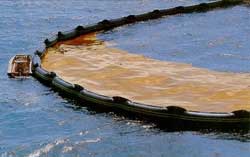
An oil spill is the release of a liquid petroleum hydrocarbon into the environment, especially the marine ecosystem, due to human activity, and is a form of pollution. The term is usually given to marine oil spills, where oil is released into the ocean or coastal waters, but spills may also occur on land. Oil spills may be due to releases of crude oil from tankers, offshore platforms, drilling rigs and wells, as well as spills of refined petroleum products and their by-products, heavier fuels used by large ships such as bunker fuel, or the spill of any oily refuse or waste oil.
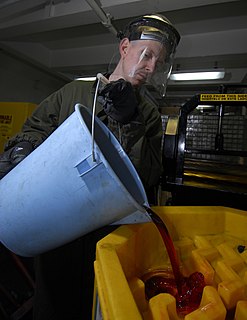
A hydraulic fluid or hydraulic liquid is the medium by which power is transferred in hydraulic machinery. Common hydraulic fluids are based on mineral oil or water. Examples of equipment that might use hydraulic fluids are excavators and backhoes, hydraulic brakes, power steering systems, automatic transmissions, garbage trucks, aircraft flight control systems, lifts, and industrial machinery.
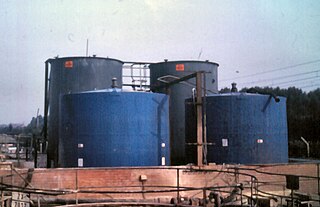
Bunding, also called a bund wall, is a constructed retaining wall around storage "where potentially polluting substances are handled, processed or stored, for the purposes of containing any unintended escape of material from that area until such time as a remedial action can be taken."
A particle counter is used for monitoring and diagnosing particle contamination within specific clean media, including air, water and chemicals. Particle counters are used in a variety of applications in support of clean manufacturing practices, industries include: electronic components and assemblies, pharmaceutical drug products and medical devices, and industrial technologies such as oil and gas.

A blowout is the uncontrolled release of crude oil and/or natural gas from an oil well or gas well after pressure control systems have failed. Modern wells have blowout preventers intended to prevent such an occurrence. An accidental spark during a blowout can lead to a catastrophic oil or gas fire.
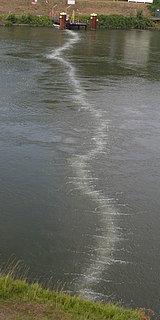
A pneumatic barrier is a method to contain oil spills. It is also called a bubble curtain. Air bubbling through a perforated pipe causes an upward water flow that slows the spread of oil. It can also be used to stop fish from entering polluted water. A further application of the pneumatic barrier is to decrease the salt-water exchange in navigation locks and prevent salt intrusion in rivers. . Pneumatic barriers are also known as air curtains. The pneumatic barrier is a (non-patented) invention of the Dutch engineer Johan van Veen from around 1940 .

The extraction of petroleum is the process by which usable petroleum is drawn out from beneath the earth's surface location.

The Prudhoe Bay oil spill was an oil spill that was discovered on March 2, 2006 at a pipeline owned by BP Exploration, Alaska (BPXA) in western Prudhoe Bay, Alaska. Initial estimates of the five-day leak said that up to 267,000 US gallons (6,400 bbl) were spilled over 1.9 acres (7,700 m2), making it the largest oil spill on Alaska's north slope to date. Alaska's unified command ratified the volume of crude oil spilled as 212,252 US gallons (5,053.6 bbl) in March 2008. The spill originated from a 0.25-inch (0.64 cm) hole in a 34-inch (86 cm) diameter pipeline. The pipeline was decommissioned and later replaced with a 20-inch (51 cm) diameter pipeline with its own pipeline inspection gauge (pig) launch and recovery sites for easier inspection.
Spill containment is where spills of chemicals, oils, sewage etc. are contained within a barrier or drainage system rather than being absorbed at the surface. One method is to use an inflatable stopper or pneumatic bladder which is inserted into the outflow of a drainage system to create a containment vessel. In the event of a spill the stopper bladder is inflated to block the drain/s and to prevent the spilled agent from entering the ground water, stream or river.

Secondary spill containment is the containment of hazardous liquids in order to prevent pollution of soil and water. Common techniques include the use of spill berms to contain oil-filled equipment, fuel tanks, truck washing decks, or any other places or items that may leak hazardous liquids.
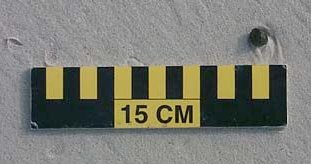
A tarball is a blob of petroleum which has been weathered after floating in the ocean. Tarballs are an aquatic pollutant in most environments, although they can occur naturally and as such are not always associated with oil spills.
Following is a timeline of the Deepwater Horizon oil spill for July 2010.
Efforts to stem the Deepwater Horizon oil spill were ongoing from the time that the Deepwater Horizon exploded on April 20, 2010 until the well was sealed by a cap on July 15, 2010. Various species of dolphins and other mammals, birds, and the endangered sea turtles have been killed either directly or indirectly by the oil spill. The Deepwater Horizon spill has surpassed in volume the 1989 Exxon Valdez oil spill as the largest ever to originate in U.S.-controlled waters; it is comparable to the 1979 Ixtoc I oil spill in total volume released.

Louhi is a Finnish multipurpose oil and chemical spill response vessel owned by the Finnish Environment Institute (SYKE), but manned and operated by the Finnish Navy. The ship, ordered in 2007, was built by Uki Workboat in Uusikaupunki, Finland, and entered service in May 2011.

Environmental impact of hydraulic fracturing in the United States has been an issue of public concern, and includes the contamination of ground and surface water, methane emissions, air pollution, migration of gases and hydraulic fracturing chemicals and radionuclides to the surface, the potential mishandling of solid waste, drill cuttings, increased seismicity and associated effects on human and ecosystem health. Research has determined that human health is affected. A number of instances with groundwater contamination have been documented due to well casing failures and illegal disposal practices, including confirmation of chemical, physical, and psychosocial hazards such as pregnancy and birth outcomes, migraine headaches, chronic rhinosinusitis, severe fatigue, asthma exacerbations, and psychological stress. While opponents of water safety regulation claim hydraulic fracturing has never caused any drinking water contamination, adherence to regulation and safety procedures is required to avoid further negative impacts.

The environmental impact of hydraulic fracturing is related to land use and water consumption, air emissions, including methane emissions, brine and fracturing fluid leakage, water contamination, noise pollution, and health. Water and air pollution are the biggest risks to human health from hydraulic fracturing. Research has determined that hydraulic fracturing negatively affects human health and drives climate change.

The Deepwater Horizon oil spill occurred between 10 April and 19 September 2010 in the Gulf of Mexico. A variety of techniques were used to address fundamental strategies for addressing the spilled oil, which were: to contain oil on the surface, dispersal, and removal. While most of the oil drilled off Louisiana is a lighter crude, the leaking oil was of a heavier blend which contained asphalt-like substances. According to Ed Overton, who heads a federal chemical hazard assessment team for oil spills, this type of oil emulsifies well. Once it becomes emulsified, it no longer evaporates as quickly as regular oil, does not rinse off as easily, cannot be broken down by microbes as easily, and does not burn as well. "That type of mixture essentially removes all the best oil clean-up weapons", Overton said.
The Ashland oil spill was an oil spill into the Monongahela River that occurred on January 2, 1988, near the town of Jefferson Hills, Pennsylvania, approximately 20 miles upstream from the city of Pittsburgh.
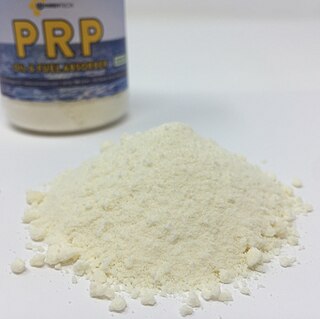
Petroleum Remediation Product (PRP) is a registered trade name of United Remediation Technology for a line of biodegradable wax-based hydrocarbon adsorbents and bioremediation agents. PRP was created in the 1990s by NASA’s Jet Propulsion Laboratory and has been used to assist in remediating oil spills such as the 2010 Deepwater Horizon oil spill. PRP is a powder composed of microscopic hollow spheres of wax up to 150 microns in size.
